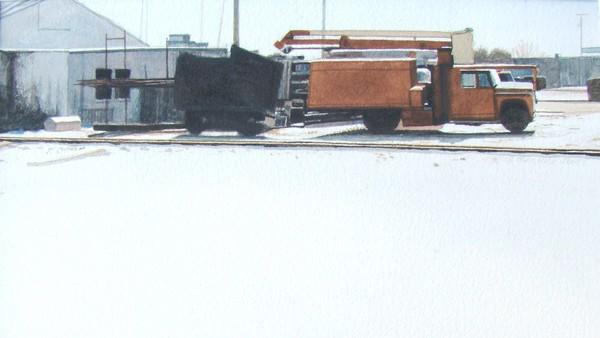John Lilley - Art Review - The James Warwick Jones Exhibit at the Peninsula Fine Arts Center in Newport News, Virginia
|
James Warwick Jones concentrates his subject matter on regional landscapes from Tidewater, Virginia. His paintings are in the realist style, and appear to be painted from photographs using acrylic on canvas. While the majority of these paintings are typical of the realist and photo-realist style, he sometimes uses impressionist or abstract elements to depict light and reflection in his works. Several Works of interest in this exhibit are Reflections (2004), Bacardi (2003), and Hilton Village - Sunlit Sidewalk (2003). Reflections concentrates on docked fishing boats and their reflections in the water. This piece is specifically interesting because the concentration of the piece is not the boats but the water. James W. Jones exhibits technical mastery of his medium in this picture, as it is very realistic looking. Even the ripples on the water are shown in an almost photographic way. This kind of realism on the water looks unnatural, however, and the painting lacks any sort of flow or movement. While Jones portrayal of the boats and the water are technically accurate, because water is so fluid and constantly moving, to see it in a photographic way is similar to a picture of a runner mid-stride with high shutter speed. The result is a lifeless painting, although technically outstanding. Bacardi is a rather large (34 x 40 inch) painting of a bottle of Bacardi Gold liquor and 2 glasses filled with the liquor and ice. Although this painting also concentrates on fluids and transparency and reflection, it is much more appealing due to its still nature. Here the photorealistic style does the subject justice. The amber shadow of the glasses on the white linen tablecloth is very well painted, capturing all the subtlety and nuance of the translucent shadows created by light through the glasses of Bacardi. The ice inside the glasses can almost be seen melting into the drink, and the reflection of light off the slick surface of the melting ice is very well painted and very realistic. This is good evidence of Jonesí unique blend of realist sensibilities and impressionist and abstract elements to make a very strong painting.
|
The first noticeable thing about Hilton Village - Sunlit Sidewalk is its sense of depth. The painting depicts a sidewalk of narrow and heavily forested road that goes off into the horizon. Jones does a great job of capturing the atmosphere in this painting, the early morning haze that eventually cuts the visibility into the horizon gives the painting depth and substance. Because of the haziness in the background caused by the use of less detail and blander color, the foreground of this painting leaps off the canvas, making it stand out in the exhibit. The other great thing about this painting is how well it displays the depth of the shrubbery surrounding the sidewalk by realistically showing the way sunlight hits leaves. This, combined with the sense of early morning atmosphere gives the work not only a sense of realism, but also a sense of life absent in most of his works. The depth here is probably slightly exaggerated from the original photograph, which is why it appears so three dimensional. While all of James Warwick Jonesí art excels at being fairly realistic, most lack a sense of flow and life, something hard to put a finger on but can be lacking even when a piece seems to be photo-realistic. The work also tends to be on the academic side of the art realm, and is more focused on portraying reality than making an artistic statement. Very little is said by these works, and because of this, more often than not, very little is felt. For this reason, James Warwick Jones is not a great artist, but he is a very good one.
|
